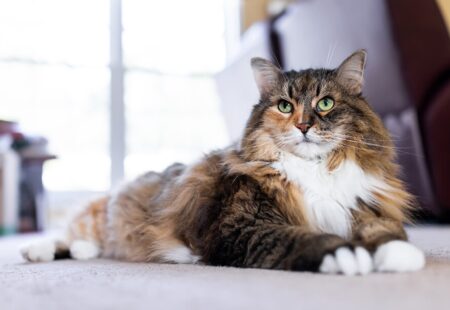
100 Weird Cat Behaviors and Their Meaning
Every internally motivated action performed by cats is an attempt by the animal to fulfill some basic needs, such as hunger, thirst, thermoregulation, habitat selection, and reproduction. All these needs are very basic and have an overpowering influence on a cat’s motivation to perform them. For instance, when your cat rubs up against you, what is she trying to say? Is her surroundings too cold? Is she suffering from a fur ball? Why does your cat sniff you? Smell your breath? Walk on you? Each of these 100 behaviors is decoded with suggestions on how to help your pet.
Cats are fascinating! There isn’t a breed of animal that has more bizarre and diverse habits than our much-loved, sometimes misunderstood, feline friends. Yet millions of cats and humans somehow manage to cohabitate and live harmonious lives with each other successfully. As slaves to our cats, we are truly in a unique position to study many aspects of their lives.
100 Weird Cat Behaviors and Their Meaning
Below are 100 weird behaviors you might see your cat exhibit and we will also go further to explain some of them.
- Kneading with their paws
- Chattering at birds
- Licking plastic bags
- Sleeping in odd positions
- Staring at walls for no reason
- Curling up in tiny spaces
- Peeking their head out of hiding spots
- Chasing their tail
- Trying to fit into small boxes
- Bringing dead prey as gifts
- Head-butting for affection
- Stalking their reflection
- Sitting on laptops or books
- Playing with toilet paper rolls
- Hissing at inanimate objects
- Kicking litter out of the litter box
- Licking or chewing on human hair
- Sitting in the sink or bathtub
- Purring when happy or content
- Meowing at empty food bowls
- Opening doors using their paws
- Stealing food from other pets
- Laying on their backs with legs in the air
- Pushing objects off tables or shelves
- Staring at their own tail
- Playing with water in their bowl
- Walking on their owner’s back
- Sleeping on dirty laundry
- Knocking over plants
- Dropping toys in their water bowl
- Stopping abruptly while running
- Licking windows or mirrors
- Rolling on the ground after eating
- Chewing on houseplants
- Attempting to climb curtains
- Putting paws over their eyes while napping
- Laying on their owner’s face while sleeping
- Obsessively grooming themselves
- Chasing laser pointers
- Walking on two legs
- Biting their own tail
- Chirping like birds
- Laying on top of paperwork or books
- Sticking their butts in the air while playing
- Playing with their own shadow
- Hiding in bags or purses
- Burying their food even though it’s not necessary
- Laying on paper or books
- Sticking their tongues out while sleeping
- Sniffing and rubbing their face on new objects
- Following their owner around the house
- Licking walls or floors
- Crying in the middle of the night for no reason
- Playing with imaginary friends
- Stealing and hoarding objects like socks
- Sleeping in the bathtub
- Crouching low to the ground while stalking prey
- Playing with their reflection in a mirror
- Chewing on household items
- Acting like they’re going to attack but never do
- Hiding behind furniture and pouncing on passersby
- Stealing food from the dinner table
- Playing with their own shadow
- Biting their owner’s toes under the covers
- Kicking their back legs while playing with toys
- Making chirping noises when seeing prey through a window
- Laying on their owner’s face while napping
- Climbing up window blinds
- Hiding in grocery bags
- Bringing home random objects from outside
- Laying on hot surfaces like laptops or radiators
- Scratching the floor after using the litter box
- Obsessively staring at food dishes
- Licking and scratching walls
- Rubbing their face on their owner’s face
- Knocking over glasses or cups
- Burying their food in empty water bowls
- Closing doors using their paws
- Sitting in cardboard boxes for hours on end
- Begging for food even though they just ate
- Letting out a loud meow after using the litter box
- Sitting on their owner’s shoulder while walking around the house
- Hiding in the laundry basket
- Jumping at their reflection in shiny surfaces
- Pawing at closed cabinets or drawers
- Jumping at insects on the ceiling
- Sleeping in the bathtub with the shower curtain closed
- Kicking toys over the edge of high surfaces and watching them fall
- Sitting on computer keyboards
- Playing with their tail
- Sticking their head in empty plastic bags
- Crying to be let into rooms they’re not allowed in
- Playing with their own shadow on a sunny day
- Hiding in dark corners or under furniture
- Jumping after invisible objects
- Sleeping on human’s heads or pillows
- Trying to catch fish in aquariums
- Chasing and pouncing on their tail
- Head-butting objects to move them
- Sleeping with their eyes partially open
SEE ALSO: All You Need To Know About Mini Bernese Mountain Dog
1. Kneading with their paws
First, it is important to know that it is a painless and healthy behavior. Kneading behavior is more common in kittens when they are nursing from their mother. Kittens are born blind, relying on their sense of touch to find their mother’s nipples. The kneading action of their paws touching the mother’s belly stimulates milk to be released for the kittens to benefit from. Even as grown-up cats, kneading is a way of showing contentment. Sebaceous glands in a cat’s paws release pheromones that can help mark their territory. When an animal spends time with someone and kneads them, it shows that he or she is comfortable and feels relaxed.
Felines are often playfully complex. When their owners look at them, they might do something unexpected. Has anyone ever watched a rhythmic motion with a cat pushing their front paws in a forward and back motion, with claws extended? This is known as kneading.
2. Chattering at birds
Cats, as feline predators, are often caught chattering, chittering, tweeting, and chirping while watching birds or squirrels. This does not sound as if the cat is going to hunt the external object, rather it instills more the impression of a creature longing or needing attention of any kind. Though some keepers are worried and consider this behavior as indicating a bad feline mental state, others laugh at it, as they have the impression that it signals fun.
3. Meowing at empty food bowls
Hunger may be the root cause although, it turns out that not all occasions of meowing at empty bowls are related to begging for food. Instead, cats appeared to be gaining the owner’s attention. They were more likely to engage in food-bowl meowing when their owner was nearby rather than absent, and they were more likely to do so while looking at the owner. At the individual level, cats seemed to differ in how often and under what circumstances they engaged in food-bowl begging. Some cats even appeared more likely to directly beg at the owner if at least one other cat was around. So in many cases, the cat is not asking for food but is instead communicating with the cat’s owner, who also happens to be the person who provides the cat with what they wants.
4. Pawing at closed cabinets or drawers
When cats paw at closed cabinets or drawers, they are working to gain access to the sounds and new challenges that are inside. In this scenario, the goal isn’t necessarily to retrieve a particular item but is instead focused on wanting access to the inside while also entertaining themselves. Very young cats or kittens like to explore and play and are attracted to one specific area of a cabinet or drawer within a home. They are motivated by being able to get to the interesting sounds that are coming from this open area. This interest in gameplay may wane as the cat ages. As this behavior drops off and the months continue, the act of pawing or reaching out may become part of the cat’s daily routine. When behaviors like tapping on cabinets, consistently scratching, or reaching out persist, both the sounds and damage to the surfaces of the cabinets or drawers producing the sounds may not stand up to the test of time.
5. Sleeping with their eyes partially open
People are known to open their eyes at a sudden noise while sleeping. A Japanese TV program called Newton’s Apple stated that cats often open their eyes only halfway as they sleep to protect themselves from being attacked or eaten by stronger animals. This behavior is rarely seen in other animals and is what is so intriguing about cats’ sleeping habits.
Unlike dogs, which sleep similarly to people, cats sleep differently. People are known to be monophasic, sleeping for one long stretch in a twenty-four-hour day. Most healthy dogs are also classified as monophasic, but they rest when awake, which is called polyphasic sleep. Cats, on the other hand, evolved into hunters. They must hunt to eat, and in turn, eat, sleep, and then go out and hunt again. So, it seems that cats are both monophasic and polyphasic sleepers, which allows them to be adaptable to any environmental situation they encounter.
SEE ALSO: All You Need To Know About Dr Marty Dog Food
FAQs
Q. What is a secret fact about cats?
Some of the secret facts about cats are that they have a whopping 32 muscles in each of their ears which allows them to swivel their ears to hone in on the exact source of noise, cats can rotate their ears to 180 degrees and cats are nearsighted but their peripheral vision and night vision are far superior compared to humans.
Q. How do cats show sadness?
Cats show sadness by displaying changes in their body language like ears held back, tucked tails, and hairs standing on end.
Q. What is abnormal cat behavior?
One of the abnormal behaviors of cats is when they do not adjust to a situation appropriately, often responding with repetitive or fixed movements or actions.


